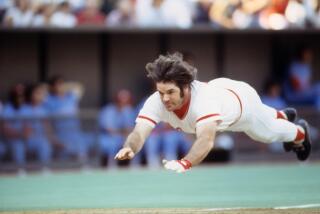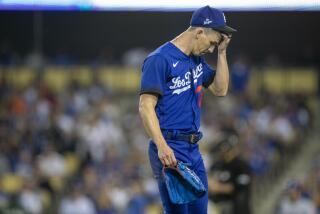When drugs put game in focus
You’ve seen the play a million times. Routine ground ball.
First baseman picks up the ball, runs it to the bag for the out, “3U” in your scorebook.
Adam LaRoche picked up the ball, but he did not run.
“I was kind of out of it,” he said.
He walked the ball to the bag. The runner beat him there.
“I wasn’t even thinking there was a runner,” LaRoche said.
The crowd booed, his home crowd. LaRoche apologized to his pitcher, then his manager.
“It looked like I was being lazy,” he said. “It looked horrible, but I wasn’t lazy.”
It was attention deficit disorder, a condition that for one day last winter overshadowed steroids on Capitol Hill. In the wake of the Mitchell Report, in a hearing that otherwise resembled a Washington victory lap for baseball’s oft-beleaguered leadership, Rep. John Tierney (D-Mass.) broke off a wicked curve.
George Mitchell had wanted to know how many medical exemptions had been granted so players could use banned substances -- “a significant loophole in some drug-testing programs,” the former U.S. senator had written in his report. Baseball had refused to hand that data to Mitchell, citing the confidentiality in its testing program.
Tierney wanted to know too, and this time baseball provided the figures rather than risk a subpoena from Congress. And Tierney read the numbers aloud, live on television: In 2006, baseball granted exemptions for ADD drugs to 28 players. In 2007, that number jumped to 103.
“This is one that needs to be dissected,” Commissioner Bud Selig told Tierney.
In a country in which ADD drugs are widely prescribed, it should come as no surprise that baseball players use them. LaRoche, then with the Atlanta Braves and now with the Pittsburgh Pirates, said he was diagnosed with the condition in high school but had avoided medication until that play at first base, two years ago, and several others like it.
“It started with a couple instances in Atlanta where I was mentally out of the ballgame,” LaRoche said.
“I didn’t have any idea how many outs there were or what inning we were in. I wasn’t able to focus.”
The Dodgers’ Andy LaRoche said he does not have ADD but sees how the drugs help his big brother.
“It’s something you need to be normal, to focus, to be like everybody else,” Andy LaRoche said. “It’s putting you on an even playing field with everybody else.
“Steroids and amphetamines, they put you on a plane above everybody else.”
That brings us back to Tierney, and to Mitchell. Had dozens of players who did not need ADD drugs started using them as an end run around baseball’s amphetamine ban?
After Adam LaRoche first told his story publicly, in Atlanta, he said several players approached him, asking about side effects of his medication. He had no sense, he said, whether those players might have been interested in an alternative to banned amphetamines.
“If they are, that’s their problem,” he said.
Andy LaRoche said he does not use the drugs but could see why a player would ask about them.
“If it’s going to make you a better player and it’s healthy for you,” he said, “who wouldn’t want to try it?”
The drugs are not without risk, said Julie Dopheide, associate professor of clinical pharmacy at USC. As stimulants, she said, they could improve concentration even in people without ADD, but side effects could include irritability and anxiety. The drugs also could increase pulse rate and blood pressure, she said, particularly dangerous to anyone with an underlying heart condition.
The numbers Tierney read raised eyebrows in the anti-doping community. Baseball reported 103 ADD exemptions among 1,354 players last year, while the U.S. Anti-Doping Agency reported 27 ADD exemptions among roughly 10,000 athletes.
Rob Manfred, baseball’s executive vice president for labor relations, would not say how many exemptions have been issued this season, or even if the number had declined. However, that number will be revealed at the end of the year, under the drug policy revisions that owners and players agreed to this month.
Manfred said no player could have gotten an exemption simply by showing a prescription -- from a team doctor, a personal physician or any doctor willing to write one.
“People get denied all the time,” he said.
He said some players might have used ADD medication for years and not realized they needed an exemption until they tested positive -- and a first positive test for stimulants results in a warning, not a suspension.
But the policy has been tightened. No longer can players test positive and then apply for an exemption, even with a prior prescription. No longer can team doctors write prescriptions for ADD drugs. And the administrator of baseball’s drug program, Dr. Bryan Smith, must investigate the medical records supporting each application.
In the minor leagues, where management can unilaterally impose rules, Manfred said baseball has certified a panel of doctors to write ADD prescriptions and will not accept any others, even if signed by a player’s personal physician.
Those policy guidelines are far from the mind of Adam LaRoche. He would just like to get his batting average on the north side of .200.
He’s lost weight, he says, a side effect of the drugs. They suppress his appetite. For the moment, he says, he is not taking the medication.
“When I take it, yeah, it helps,” he said. “But when I’m off of it, it’s not like it’s a huge drop-off, because I’m taking such a small amount.
“I can play without taking anything, like right now, which I choose to do so I can eat.”
--
More to Read
Go beyond the scoreboard
Get the latest on L.A.'s teams in the daily Sports Report newsletter.
You may occasionally receive promotional content from the Los Angeles Times.











